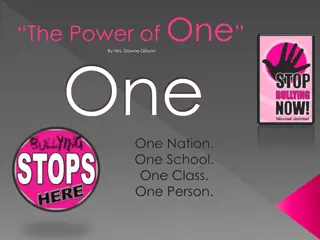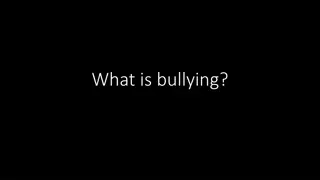Understanding and Addressing Academic Bullying in Educational Settings
Academic bullying involves intentional, repetitive, and hostile behavior that creates a threatening environment leading to psychological and physical harm. This initiative by the Graduate School at Virginia Tech aims to disrupt academic bullying by identifying types of bullying, defining roles, and recognizing bullying behaviors. It emphasizes the importance of bystander intervention and highlights strategies to identify different types of bullies in academic settings.
Download Presentation

Please find below an Image/Link to download the presentation.
The content on the website is provided AS IS for your information and personal use only. It may not be sold, licensed, or shared on other websites without obtaining consent from the author. Download presentation by click this link. If you encounter any issues during the download, it is possible that the publisher has removed the file from their server.
E N D
Presentation Transcript
Disrupting Academic Bullying An Initiative by the Graduate School at Virginia Tech
What is Bullying? Intentional behavior targeted at an individual or group that is repeated, hostile or offensive, and creates an intimidating and/or threatening environment which produces a risk of psychological and/or physical harm.
Forms of Bullying* Indirect manipulative aggression: Aggressive acts involving a peer group such as spreading rumors or isolating someone from their group. Covert insinuative aggression: When the aggressive act is disguised in the form of malicious insinuations and suggestions such as imitating the person in an insulting manner. Rational appearing aggression: Characterized by the bully s attempt to conceal their intention to hurt the victim by shrouding their aggressive acts in seemingly rational actions. Often these acts appear to others as everyday communication and not as targeted attempts at aggression. Relational Aggression: The point of relational aggression is to manipulate or disrupt relationships and friendships. Mobbing: Gang bullying or group bullying is often called mobbing and usually involves scapegoating and victimization. * From: Morris, J. (2014) . The Influence of Bystanders in Subsequent Bullying Behavior.
Defining the Roles Directly involved Target: Someone against whom mistreatment is directed. Aggressor: Someone who repeatedly and consistently says or does something harmful or malicious to another person. Observers Passive bystander: Someone who sees something happening and does not say or do anything. Active bystander/Upstander: Someone who speaks out on behalf of someone else or takes actions that are supportive of someone else.
Identifying Bullies* Chronic: Those who use aggressive, dominating, and coercive strategies in nearly every encounter in and out of work/classroom. Opportunist: Those who suspend their aggressive behavior outside of work but believe careers are built with political gamemanship . Accidental: Those who unknowingly take actions that victimize recipients, and may retreat/apologize when confronted about the behaviors. Substance-abusing: Those bullying behaviors initiated by substance abusers where rationality and logic are tossed out the window . * From: Theiss, S. (2005). Bullying in Academia: What s an Ombudsman to do?
Bullying Behaviors Continual threats of dismissal or intimidation. Attempts to destroy or harm the person s self-esteem or confidence. Constant negative remarks or repeated criticism or sarcasm. Consistent over time, unrealistic work demands, or work overloading. Isolating or systematically isolating the person. Spreading false information or rumors. Tasks that are ambiguous, contradictory, or that are deprived of purpose. False insinuations, attacks to the individual's dignity, integrity, or self- image. Attempts to humiliate or public humiliation.
Why Address Bullying Now? Promote civility Uphold Principles of Community Increase productivity Decrease absenteeism/disengagement Model constructive group dynamics Influence higher morale
Institutional Factors that Foster Bullying Inherent power differentials within academic institutions Proliferation of disrespectful communication styles Focus is on development of specialized knowledge Competition for finite resources
Disrupting Bullying as a Target Procedural Seek allies Approach a higher level of authority Submit a report Reach out to Ombudsperson to navigate process Self-care Find outlets to reduce stress Build your professional network Strengthen identity outside of work Consider support from mental health professionals
Disrupting Bullying as a Bystander In the moment Acknowledge that you are witnessing behavior that qualifies as bullying. Ask the target if they would like assistance. Shut down bullying behaviors in group situations. Follow-up action Reach out to the target of the bullying behavior. If appropriate, speak to the aggressor in private about their behavior. Know the resources available for the target and yourself. Submit a report via this referral form.
Disrupting Bullying as a Leader Directly Listen and Observe Consistent Response to Complaints Annual Review Process Indirectly Set Expectations for Conduct Awareness when Recruiting Train for Awareness
Resources Available Disrupting Academic Bullying Website https://graduateschool.vt.edu/student-life/we-hear-your-voice/disrupting_academic_bullying.html Academic Bullying Referral form https://virginiatech.qualtrics.com/jfe/form/SV_3gR6CDbKkf6OrtP Cook Counseling https://ucc.vt.edu/ Equity and Access https://oea.vt.edu/about/requesting-assistance.html Office of Inclusion and Diversity https://www.provost.vt.edu/who_we_are/inclusion_diversity.html Dean of Students https://www.dos.vt.edu/ Ombudsperson https://graduate.ombudsman.vt.edu/
Cases for Reflection Cases available for reflection on website: https://graduateschool.vt.edu/case-studies-academic-bullying























